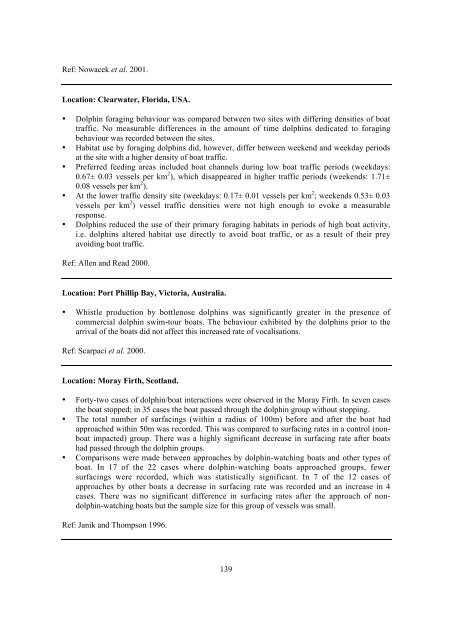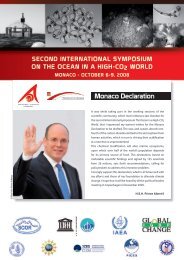Oceans of noise - Whale and Dolphin Conservation Society
Oceans of noise - Whale and Dolphin Conservation Society
Oceans of noise - Whale and Dolphin Conservation Society
- No tags were found...
You also want an ePaper? Increase the reach of your titles
YUMPU automatically turns print PDFs into web optimized ePapers that Google loves.
Ref: Nowacek et al. 2001.Location: Clearwater, Florida, USA.• <strong>Dolphin</strong> foraging behaviour was compared between two sites with differing densities <strong>of</strong> boattraffic. No measurable differences in the amount <strong>of</strong> time dolphins dedicated to foragingbehaviour was recorded between the sites.• Habitat use by foraging dolphins did, however, differ between weekend <strong>and</strong> weekday periodsat the site with a higher density <strong>of</strong> boat traffic.• Preferred feeding areas included boat channels during low boat traffic periods (weekdays:0.67± 0.03 vessels per km 2 ), which disappeared in higher traffic periods (weekends: 1.71±0.08 vessels per km 2 ).• At the lower traffic density site (weekdays: 0.17± 0.01 vessels per km 2 ; weekends 0.53± 0.03vessels per km 2 ) vessel traffic densities were not high enough to evoke a measurableresponse.• <strong>Dolphin</strong>s reduced the use <strong>of</strong> their primary foraging habitats in periods <strong>of</strong> high boat activity,i.e. dolphins altered habitat use directly to avoid boat traffic, or as a result <strong>of</strong> their preyavoiding boat traffic.Ref: Allen <strong>and</strong> Read 2000.Location: Port Phillip Bay, Victoria, Australia.• Whistle production by bottlenose dolphins was significantly greater in the presence <strong>of</strong>commercial dolphin swim-tour boats. The behaviour exhibited by the dolphins prior to thearrival <strong>of</strong> the boats did not affect this increased rate <strong>of</strong> vocalisations.Ref: Scarpaci et al. 2000.Location: Moray Firth, Scotl<strong>and</strong>.• Forty-two cases <strong>of</strong> dolphin/boat interactions were observed in the Moray Firth. In seven casesthe boat stopped; in 35 cases the boat passed through the dolphin group without stopping.• The total number <strong>of</strong> surfacings (within a radius <strong>of</strong> 100m) before <strong>and</strong> after the boat hadapproached within 50m was recorded. This was compared to surfacing rates in a control (nonboatimpacted) group. There was a highly significant decrease in surfacing rate after boatshad passed through the dolphin groups.• Comparisons were made between approaches by dolphin-watching boats <strong>and</strong> other types <strong>of</strong>boat. In 17 <strong>of</strong> the 22 cases where dolphin-watching boats approached groups, fewersurfacings were recorded, which was statistically significant. In 7 <strong>of</strong> the 12 cases <strong>of</strong>approaches by other boats a decrease in surfacing rate was recorded <strong>and</strong> an increase in 4cases. There was no significant difference in surfacing rates after the approach <strong>of</strong> nondolphin-watchingboats but the sample size for this group <strong>of</strong> vessels was small.Ref: Janik <strong>and</strong> Thompson 1996.139




